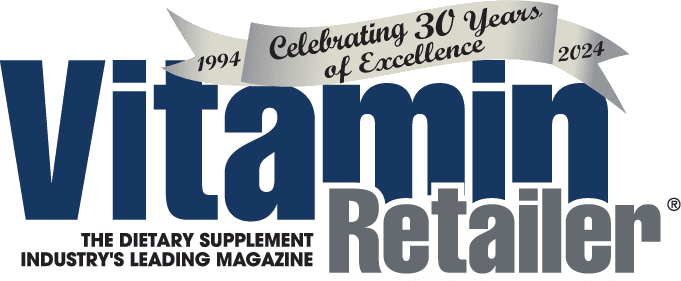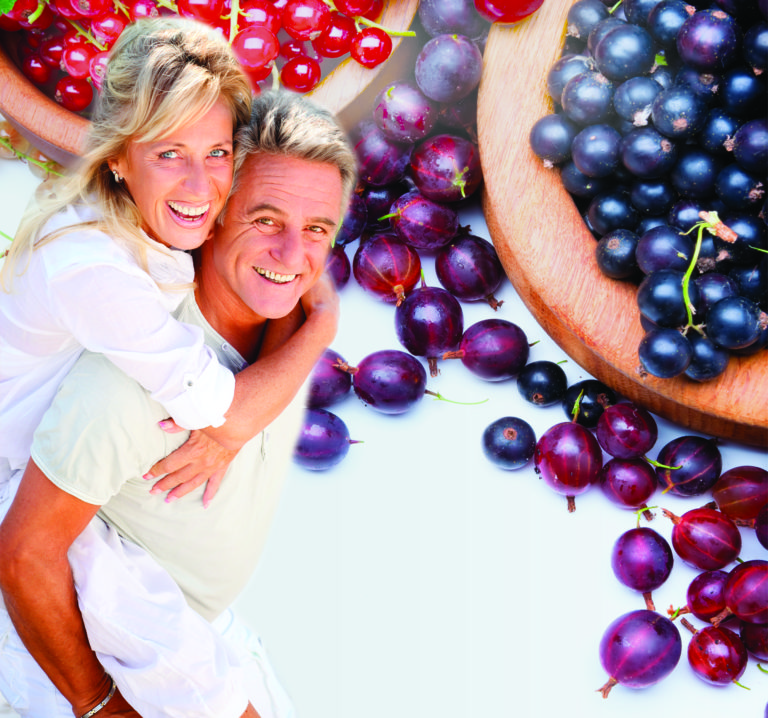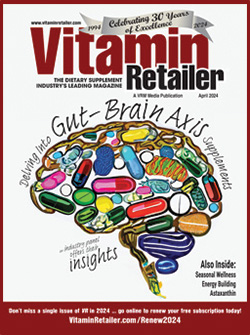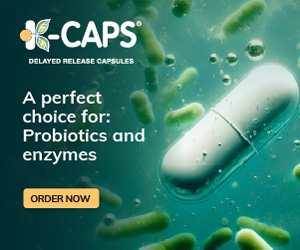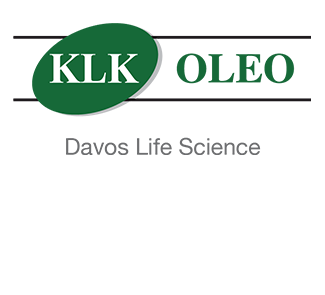Baby Boomers concerned with healthy aging and prevention are the main force behind antioxidant sales.
Many consumers already know fruits such as blueberries and cranberries, as well as antioxidant-rich supplements, may have the ability to support their immune systems, combat aging and possibly even help in the fight against cancer. With that knowledge top-of-mind, antioxidants have become one of the best-selling supplements available today.
According to data from SPINSscan Natural, in 2012 consumers spent more than $25 million on the antioxidants vitamin C (not ester-C); more than $19 million on coenzyme Q10; more than $1 million on astaxanthin; and more than $1 million on grape seed extract.
“There’s an antioxidant buzz, and it’s catching on again,” said Brett Taylor, owner of Good Earth Healthfoods in Edmond, OK, who grew up around his family’s health food store before taking over after college. “As long as retailers get the right products into the hands of the right customers, I think we’ll see the upward trend continue.”
Jane Thomas, president of JB’s Health Mart in West Plains, MO, said her store’s antioxidant sales do especially well. “Customers have a high level of curiosity about products that can enhance and protect their health,” she said. “And due to the demographic of our customers, they are very interested in antioxidants for a variety of reasons.”
Thomas, who has been involved with holistic health for more than 30 years, said her consumer base is primarily women over the age of 40 who are looking to protect their good health into the future. “Women are especially concerned with beauty preservation, energy, longevity and being fit and active into their ‘wisdom years’ and beyond,” she said. However, Thomas noted she has also noticed over the past few years that more men are becoming interested in using supplements for health preservation as well.
Baby Boomer Generation
The Baby Boomer generation is seeking antioxidant supplements for healthy aging benefits, such as brain and joint support.
“We’re seeing people who are a little bit older, and who are starting to notice that their bodies just don’t perform at The same level,” said Taylor. “I remember in the 1990s and early 2000s, antioxidants were a big preventative seller. Now they’re a treatment sale for a preexisting condition.”
Pim Schwitters, sales and marketing director of INC Agency in the Netherlands, parent company of the U. S. brand MASQUELIER’s USA, agreed. “Of course the growing Baby Boomer population is increasing health product sales across the board, and anti-aging products will appeal to them the most as they are seeing the results of aging in their mirrors every day.”
One of the company’s newest products from MASQUELIER’s USA is French Pine Bark, which offers powerful antioxidant protection and collagen support, and also assists in the healthy functioning of the vascular system. “Being a single- focus company, our formula features the original French pine bark products, as discovered and researched by Professor Jack Masquelier, blended with the unique Original OPCs ingredient that he also developed,” Schwitters said. MAQUELIER’s OPCs, an OPC (oligomeric proanthocyanidins) extract derived from grape seeds, is a highly effective antioxidant that works by scavenging free radicals in the body.
EuroPharma is another company seeing Boomers partaking in their antioxidant products. “For anyone in the Boomer demographic, antioxidants are already quite popular because of their healthy aging and immune-boosting power,” said Cheryl Myers, head of education and scientific affairs at the Wisconsin-based company, where antioxidants have been a part of the original focus since they began in 2003.
The company has released under the Terry Naturally brand CuraMed BCM-95 curcumin, a better-absorbed antioxidant that has been at the forefront of some recent clinical studies. Curcumin, from the Indian spice turmeric, is a well-known antioxidant. According to Myers, EuroPharma’s BCM-95 has up to 10 times better absorption and blood retention than standard curcumin extracts because of the way it is formulated. It starts with micronized curcumin extract, and in a unique process, blends with turmeric essential oils that enhance absorption.
“Curamed by EuroPharma is a product that I faithfully use twice a day,” said JB’s Health Mart’s Thomas. “Each capsule is equivalent to 10 caps of plain curcumin, the constituent in turmeric responsible for the many health benefits. [It] is a super concentrated, highly absorbable product that is anti-inflammatory, immune boosting, supportive of the circulatory system, prevents oxidative damage and is resistant to free radical activity. It’s a wise choice for aging Boomers who want to protect their brains.”
Tina Chan, founder and CEO of Powbab, Inc., makers of the antioxidant immunity supplement Baobab Superfruit Chews, agreed that Boomers are the driving force behind antioxidants due to the rising cost of medical care and their desire to stay healthy, but she also noted that the benefits of antioxidants are not lost on the youth of today. “The ‘Millennial’ generation is more engaged with reading nutrition labels and health news Than their parents were,” she said. “Likely the Millennials will continue to devour such information as they experience the prevalence of disease in the general population.”
This was seen firsthand this past year at Bastyr University for Natural Health in Kenmore, WA, where the average student is age 31. Marty Peterson, store manager of the university’s bookstore, has been selling Baobab Superfruit Chews for the past eight months. “The people who had them said they saw some immune benefits,” Peterson said. “It was especially obvious this last quarter here on campus when the Northwest got hit with cold and flu, so
[the supplement] certainly didn’t hurt.”
Chan said the chews have been the company’s top-selling product. The baobab chews contain 750 mg of baobab fruit, an antioxidant-rich fruit that has been consumed by Africans and ancient Egyptians for thousands of years. “Staying healthy through preventative care and good nutrition, such as boosting antioxidant intake, will become more important and desired,” Chan said.
More Than a Buzzword
EuroPharma’s Myers said she believes that the term “antioxidant” has become a background hum to supplement marketing and doesn’t really connect in importance to the customer. “I think that one of the biggest challenges to retailers is that antioxidants appear to be ‘everywhere,’” she said. “Because of the popularity of this supplement category, the term ‘antioxidant’ has become ubiquitous and has started to lose its meaning. Many consumers know that antioxidants are good for them, but do they know how or why, or even what they really are?”
According to MayoClinic.com, antioxidants are compounds that may help neutralize free radicals, which are toxic byproducts of natural cell metabolism. Free radicals can also be introduced into the body by exposure to things like environmental toxins, such as cigarette smoke, radiation or pesticides. Free radicals perform some useful immune functions, but in excess or in the wrong place, they can damage healthy cells through a process called oxidation. The chemical process of oxidation is thought to be a factor in the development of certain diseases like cancer, Alzheimer’s disease and chronic fatigue syndrome. “Oxidation affects our DNA, our cellular division, immune response, muscle recovery, mental health, fatigue, skin health, aging—you name it,” Myers said.
Antioxidant molecules are thought to inhibit the oxidation of other molecules. According to NaturalStandard.com, oxidation transfers electrons from a substance to an oxidizing agent, which in turn may produce free radicals. These molecules then start chain reactions of their own. When this reaction occurs in a cell, it can cause damage or cell death. Antioxidants may stop these chain reactions, in some instances by being oxidized themselves, thus preserving healthy cells.
Polyphenols are one type of antioxidant that can help protect cells from oxidation, according to Medterms.com. They are found in phyto-chemical fruits such as pomegranates, cranberries, grapes, aronia berries and in vegetables like broccoli, onions and parsley. Polyphenols can also be found in red Wines, chocolate, green tea, argan oil and olive oil.
The biochemical theory behind polyphenol antioxidants states that they work by scavenging free radicals. Polyphenols may even result in a possible reduction of inflammation for people with coronary heart disease. In addition, they may have anti-aging effects on the skin, but more research is needed before solid claims can be made.
Ascorbic acid, a form of vitamin C, is another compound with antioxidant properties. According to NaturalStandard.com, vitamin C decreases oxidants in gastric juice, lipid peroxidation, and oxidative DNA and protein damage.
Delivery Systems
It is important how antioxidants are delivered as a supplement for them to have maximum benefit. “I think you’re seeing a lot of functional foods and other delivery systems available at the grocery store level that may compete with more traditional antioxidants in supplement form—at least initially,” Myers said. “However, as customers become more aware of the importance of strong antioxidants (and the cost and calorie count of some of the other fortified food choices), I think that initial interest will shift over to stronger, clinically tested supplemental forms available at health food stores.”
As previously mentioned, Powbab is offering antioxidants in chew form, which founder Chan said are tasty and convenient. She also noted that drink mixes and beverages are a major trend in current delivery methods. “The delivery format will continue to evolve, creating opportunity for new products and new emerging categories within antioxidants,” said Chan.
Texas-based Genesis Today has been experiencing great success with more traditional oral delivery forms, such as liquids and vegetarian capsules. The company offers Genesis Today Pycnogenol, Saffron, Green Coffee Bean, Green Coffee Bean with Svetol, and Skinny Coffee, all containing antioxidants.
Still, topical delivery is a growing trend, as is the case with MAQUELIER’s OPCs. According to the company’s website, MASQUELIER’s OPCs, when taken as a food supplement, help scavenge free radicals throughout the body. But an extensive clinical trial also showed that MASQUELIER’s Original OPCs were very active when applied to the skin from the outside in cream form. The cream, such as the Anthogenol Crème, works in the skin to neutralize free radicals and inhibit the onset of the inflammatory response.
According to Good Earth Healthfood’s Taylor, it’s all about the ease of the product. “Generally, customers want a good antioxidant that’s easy to take, and which will provide a noticeable difference.”
Antidepressant Benefits of Antioxidants
EuroPharma’s Cheryl Myers offered some recent studies that showed curcumin BCM-95 to have an antioxidant effect similar to that of Prozac. “It reduces inflammatory markers in the bloodstream, which travel through the brain, and it prevents low levels of serotonin, noradrenaline and dopamine,” she said. “Plus, research shows that curcumin also promotes neurogenesis (brain cell formation) notably in the frontal cortex and hippocampal regions of the brain.”
In the study, BCM-95 was compared to antidepressant fluoxetine (also known by the tradenames Prozac, Sarafem and Fontex, among others) and imipramine (one brand name of Tofranil) in a scientific model of depression. According to Myers, the study tested two different doses and noted how well it worked as an “add on” therapy with these two commonly prescribed drugs. “The BCM-95 curcumin worked remarkably well. It was just as effective in alleviating depression as either prescription drug, but without side effects,” she said, noting that this could be due to an increase of serotonin, norepinephrine and dopamine levels in the brain.
In a study by Xu et. Al, the antidepressant effects of curcumin were studied in a forced swim test and olfactory bulbectomy (OB) model of depression in rats. According to the study, the team hypothesized that curcumin would have an influence on depressive-like behaviors based on its use in traditional Chinese medicine where it was used to effectively manage stress and depression-related disorders. In the first study, chronic treatment with curcumin over 14 days reduced the immobility time in forced swimming tests.
A second study revealed that curcumin reversed the OB-induced behavioral abnormalities, such as hyperactivity in the open field, as well as deficits in step-down passive avoidance. OB-induced low levels of serotonin, noradrenaline, high 5-hydroxyindoleacetic acid and 4-dihydroxyphenylacetic acid in the hippocampus were observed and completely reversed by curcumin administration.
According to researchers, “these results confirm the antidepressant effects of curcumin in the forced swim and the OB models of depression in rats, and suggest that these antidepressant effects may be mediated by actions in the central monoaminergic neurotransmitter systems.”
